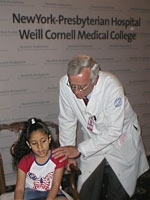The Medical College and the William Randolph Hearst Burn Center joined forces with the New York State Consumer Protection Board on July 1 to urge New Yorkers to avoid illegal fireworks, citing an increase in fireworks-related injuries last year.

Dr. Yurt listens to 6-year-old Nidia Santos as she talks to the media about the burn injuries she suffered last year.
At a press conference held in the Griffis Faculty Club, Dr. Roger Yurt, the Johnson & Johnson Distinguished Professor of Surgery and director of the Hearst Burn Center, Dr. Herbert Pardes, president and CEO of NewYork-Presbyterian Hospital, Theresa Santiago, chairperson and executive director of the New York State Consumer Protection Board, and Fire Marshal Louis Garcia, representing the New York City Fire Department, spoke about the need for burn safety during the July 4th holiday and offered statistics and tips related to burn safety. Six-year-old Nidia Santos was also present and talked about the injuries she suffered last summer after stepping on barbecue coals left carelessly in the grass at a park. Nidia, who spent two weeks at the Hearst Burn Center while she recuperated from injuries sustained to her feet, has no problem walking, running, or even dancing today.
In 2002, 30 New Yorkers suffered moderate to severe burn injuries from fireworks, including four children 6 years of age and younger. More than half of these injuries occurred in July. Dr. Pardes said, "We have to alert citizens around the entire nation about ways they can protect themselves and their families. There are more accidents than we'd like. We want the record to be zero."
According to the New York State Department Office of Fire Prevention and Control, it is unlawful for any person to use illegal fireworks such as roman candles, cherry bombs, M-80s, M-100s, shells and mortars, bottle rockets, firecrackers and more. However, professional public displays such as Macy's annual fireworks show, are permitted.
Ms. Santiago re-emphasized the illegality of fireworks, adding that the danger is compounded when people use devices that are homemade. "Parents need to be vigilant of their children and teenagers. Many fireworks are bought off the Internet. Obey the law and leave the fireworks display to the professionals."
Dr. Yurt noted that the problem is not only limited to those who use fireworks: "The people that are watching the fireworks are the ones getting injured." He continued, "Each year, 100,000 people are hospitalized as a result of burn injuries caused by fireworks and barbecues. Yet many of these accidents could have been avoided if these individuals took the time to follow basic burn safety measures."
In 1993, there were 71 incidents of burn injuries in New York State associated with fireworks. Although the number of injuries had significantly declined since then—with only 14 reported cases in 2001—in 2002 the number jumped to 30. Ms. Santiago said that with the exception of last year, the steady decrease in fireworks-related injuries was due in part to the efforts of police and fire units in seizing illegal fireworks. Last year, New York City seized 1,167 cases of fireworks and made 21 arrests. This year alone, seven people have been arrested; three people have been injured; and more than 800 cases of fireworks have been seized.
"We urge people to report fireworks to the FDNY fire tip hotline, (800) FIRETIPS," said Mr. Garcia.
Photo by Shonda Prince-Hall.

